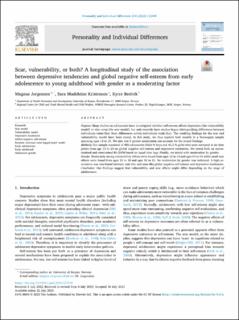Scar, vulnerability, or both? A longitudinal study of the association between depressive tendencies and global negative self-esteem from early adolescence to young adulthood with gender as a moderating factor
Journal article, Peer reviewed
Published version

Åpne
Permanent lenke
https://hdl.handle.net/11250/3094750Utgivelsesdato
2023Metadata
Vis full innførselSamlinger
Originalversjon
Personality and Individual Differences. 2023, 214, 112349. 10.1016/j.paid.2023.112349Sammendrag
Purpose
Many studies on adolescents have investigated whether self-esteem affects depression (the vulnerability model) or vice versa (the scar model), but only recently have studies begun distinguishing differences between individuals (state-like) from differences within individuals (trait-like). The resulting findings for the scar and vulnerability model have been mixed. In this study, we thus explore both models in a Norwegian sample spanning ages 13 to 23. We also test if gender moderation can account for the mixed findings.
Methods
Our sample consisted of 985 adolescents (54,8 % boys and 45,2 % girls) who were surveyed at six time points from age 13 to 23 on global negative self-esteem and depressive tendencies. We tested both an unconstrained and constrained RI-CLPM based on equal time lags. Finally, we tested with moderation by gender.
Results
Moderately strong vulnerability effects were found from ages 13 to 14 and ages 14 to 15 while small scar effects were found from ages 15 to 18 and ages 18 to 21. No moderation by gender was indicated. A high association was also found between trait-like and state-like global negative self-esteem and depressive tendencies.
Conclusion
Our findings suggest that vulnerability and scar effects might differ depending on the stage of adolescence.
